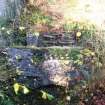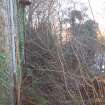Notice
Following a review of the Buildings at Risk Register we have paused the Register while we consider options for its future.
The website will remain accessible and searchable during this time, but it will not be updated and we’re not accepting nominations for additions to the Register. If you need to contact us about the BARR please email hmenquiries@hes.scot
Read the review report here and you can find out more about why we have paused the BARR on our news centre.
Oakbank Mill, Oakbank Road, Blairgowrie
Ordnance Survey licence number AC0000807262. All rights reserved. © Copyright and database right 2025. Public Sector Viewing Terms
Useful Links
- Canmore:
- BLAIRGOWRIE, OAKBANK MILL
- Historic Scotland:
- HS Reference No 5679
General Details and Location
Category
AT RISK
Name of Building
Oakbank Mill
Other Name(s)
Address
Oakbank Road, Blairgowrie
Locality
Postcode
Planning Authority
Divisional Area
Reference No
1239
Listing Category
B
OS Grid Ref
NO 17689 46204
Location Type
Rural
HS Reference No
5679
Description
A 3-storey and basement 5-bay rubble mill building with a 2-bay extension. At basement level is a ruined wheel house with a breast wheel about 10 ft (3.05m) wide by 18 ft (5.49m) diameter, with rim gearing. The main drive shaft, which is vertical, runs up the face of the building. (J Hume)
At one time the Grimond family controlled 4 of the twelve mills (including Oakbank) in the Blairgowrie area, having originally owned a lint mill on the Lornty Burn (J Shaw). JAR MacDonald's History of Blairgowrie, 1899, suggests that James Grimond was the first spinner Watt "induced to make a trial of jute." On James Grimond's death David Grimond (his nephew) suceeded. Oakbank Mill was burned down in the spring of 1872, the fire arising from a gas jet igniting some of the tow.
The mill remains one of a group of flax and jute mills that run along each side of the River Ericht, a classic example of a large colony of mills sited expressly for the purpose of exploiting a good water supply, said to be the oldest of their type in Scotland.
At one time the Grimond family controlled 4 of the twelve mills (including Oakbank) in the Blairgowrie area, having originally owned a lint mill on the Lornty Burn (J Shaw). JAR MacDonald's History of Blairgowrie, 1899, suggests that James Grimond was the first spinner Watt "induced to make a trial of jute." On James Grimond's death David Grimond (his nephew) suceeded. Oakbank Mill was burned down in the spring of 1872, the fire arising from a gas jet igniting some of the tow.
The mill remains one of a group of flax and jute mills that run along each side of the River Ericht, a classic example of a large colony of mills sited expressly for the purpose of exploiting a good water supply, said to be the oldest of their type in Scotland.
Building Dates
Pre 1832?; Rebuilt 1872
Architects
Unknown
Category of Risk and Development History
Condition
Poor
Category of Risk
Moderate
Exemptions to State of Risk
Field Visits
June 1990, December 1999, December 2000, January 2002, 10/09/2009, 06/11/2011
Development History
June 1990: External inspection reveals the mill to be empty and derelict. August 1993: A member of the public reports that the east block retains its slate roof, though there is a noticeable dip near the east gable. The west block is roofed in asbestos, which is holed in several places. The main wall remains intact apart from the south elevation of the west building. 2 distinct outbreaks of dry rot have occurred in the east building, and the ends of most of the lower floor timbers have rotted. Floors in the west section have collapsed, and without internal bracing the south elevation is leaning outwards. None of the windows remain intact, leaving the mill open to the elements. Access to the mill is currently problematic, due to a disputed right of way with the owner of Keathbank Mill opposite, and the partial collapse of the access road from the town centre. The mill was being marketed but has now been withdrawn whilst the District Council's Legal Department investigates the access dispute. A restoring purchaser has shown an interest in the property, and proposes to convert the top floor into living accommodation, and lower floors into a display and exhibition space and music workshops. August 1993: The District Council meets to debate future plans for the mill. There is agreement that it should be remarketed. 13 January 1994: The Blairgowrie Advertiser reports on the mill's inclusion in the Buildings at Risk Bulletin. February 1994: SCT understands the mill may have been acquired by a restoring purchaser. February 1997: SCT understands that the mill subsequently reverted back to Council ownership because the private restorer did not fulfill all the conditions of sale. April 1998: The mill is again to be marketed. 23 July 1998: The Blairgowrie Advertiser reports on the mill's inclusion in the Buildings at Risk Bulletin. November 1998: The mill is now under offer for restoration as a private home. June 1999: Listed Building Consent is sought for the conversion. December 1999: External inspection reveals that works have not yet commenced. January 2000: The mill is once again being marketed, with permissions attached for its conversion into a dwelling and ancillary flat, via Finalyson Hughes of Perth. October 2001: The agents report that the mill has now been sold and that the purchasers intend to restore. January 2002: External inspection reveals that the property continues to deteriorate. December 2003: Perth and Kinross Heritage Trust reports that it provided grant aid early in the year for replacement windows. The roof has been repaired and stonework repointed. The conversion of the interior into a single dwelling has not yet commenced. June 2006: Local planners report that the building recently received grant aid from PKHT and that the mill is now wind and water tight.
March 2009: SCT is contacted by a member of the public who advises the building windows have been boarded up (although one at the rear which had a board but has been removed by someone). The roof has been repaired, skylights refitted, stonework cleaned.
September 2009: External inspection finds repairs have been made to the roof, rainwater goods and windows (though some remain boarded over to the front and most to the rear) Some window panes are smashed and the gutters are clogged with grass. The building remains unused.
A preliminary feasibility study on behalf of Blairgowrie and Rattray Regeneration Company, explored the possibilty of developing a multi-sited tourist attraction pricipally along the River Ericht. It cited the Mill as having the potential for reuse as a hotel/ restaurant and visitor centre.
A preliminary feasibility study on behalf of Blairgowrie and Rattray Regeneration Company, explored the possibilty of developing a multi-sited tourist attraction pricipally along the River Ericht. It cited the Mill as having the potential for reuse as a hotel/ restaurant and visitor centre.
November 2011: External inspection finds a marked deterioration since the previous site visit in 2009. Broken window glazings and astragals, clogged gutters and slipped slates are the more obvious concerns. The external wheel machinery is now in an advanced state of decay.
17 April 2012: A member of the public advises that one of the rooflights towards the lower end of the mill has been broken, but all windows are now boarded over.
2 July 2012: One of the owners of the mill advises the property is to be marketed for sale through agents Calum Innes at CKD Galbraith.
11 July 2012: The owners advise the property is being marketed at £150,000, through Calum Innes of CKD Galbraith.
4 July 2013: The property remains under marketing for sale through agents CKD Galbraith at a guide price of £150,000.
6 February 2014: External inspection finds the building remains in much the same condition as seen previously. The window openings are externally or internally boarded up.
16 September 2014: The property is thought to have been sold to new owners. Full Planning Permission for change of use from mill to dwellinghouse, holiday let accommodation and formation of walkway and balcony is being sought ref: 14/01496/FLL.
29 July 2015: Full Planning Permission and Listed Building Consent for restoration and conversion to form a dwelling with separate holiday accomodation are being sought ref: 15/01226/FLL & 15/01227/LBC.
15 July 2024: Building warrant (16/00560/DOM2) notes building works relating to previously noted consents started - desk-based assessment suggests whilst some repairs have been completed, the building remains disused.
Guides to Development
Conservation Area
Planning Authority Contact
PAC Telephone Number
Availability
Current Availability
Unknown
Appointed Agents
Price
Occupancy
Vacant
Occupancy Type
N/A
Present/Former Uses
Building Uses Information:
Present Use 1: N/A Former Use 1: Mill
Present Use 2: N/A Former Use 2: N/A
Present Use 1: N/A Former Use 1: Mill
Present Use 2: N/A Former Use 2: N/A
Name of Owners
Unverified see FAQ on ascertaining ownership
Type of Ownership
Unknown
Information Services
Additional Contacts/Information Source
Bibliography
Hume (1976-1977), vol. II, p257. JAR MacDonald's History of Blairgowrie, 1899 Water Power in Scotland 1550-1870 (1984) John Shaw p 261.
Online Resources
Classification
Textile Industries
Original Entry Date
19-JUN-90
Date of Last Edit
16/09/2014
















